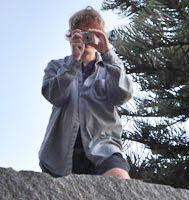 I recently purchased a Canon SD85oIS. It's almost exactly the same size as my much older SD110 (purchased in March of 2005). The SD110 was the second Powershot in the SD line, but it wasn't that new a design - Several of the S series of cameras had almost identical form factors, except for using a Compact Flash card instead of an SD card.
I recently purchased a Canon SD85oIS. It's almost exactly the same size as my much older SD110 (purchased in March of 2005). The SD110 was the second Powershot in the SD line, but it wasn't that new a design - Several of the S series of cameras had almost identical form factors, except for using a Compact Flash card instead of an SD card.Side by side with the SD850IS you can see they share some common linage, but a lot has changed.
The 850 is much more curved. In theory this should make it rest more comfortably in your pocket, and indeed I feel this is true, though it's subtle. A really big change is the size of the LCD, which covers almost the entire backside of the 850. It's a very nice screen to frame and review photos, but it does mean that the camera doesn't have a good surface to hold onto any more. The SD110 had lots of open space for you to rest your thumb and other fingers, making it easy to hold securely. I'm still working on finding an effortless-but-secure grip on the SD850. I fear I may never find it.
The mode dial is recessed on the SD850, which again probably makes it easier on your pocket. But the SD110's mode dial was easier to flick into position. The zoom level on the SD110 was also a bit bigger than on the SD850. In this one case, it seems that the reduction in protrusions has no downside - both the SD850 and the SD110 are equally easy to zoom.
Interestingly, the UI for the camera is almost unchanged from the SD110 to the SD850. There are a few new options, and most notably, it's much easier to change the ISO setting, but on the whole the same menu structures and button names are used accross the whole SD line. I think this reflects the high quality of the SD110's menus - Canon figured out a good system way back then (or likely, earlier) and has stuck to it.



